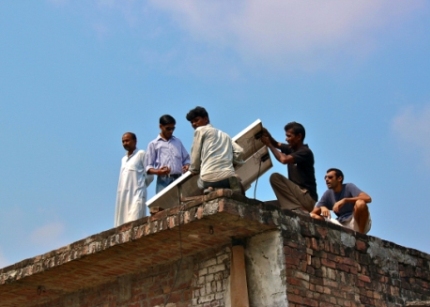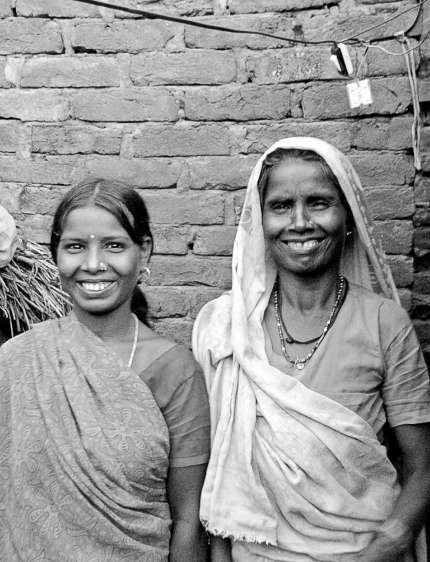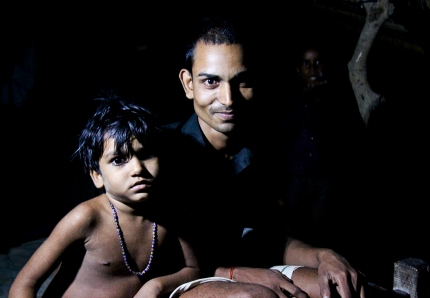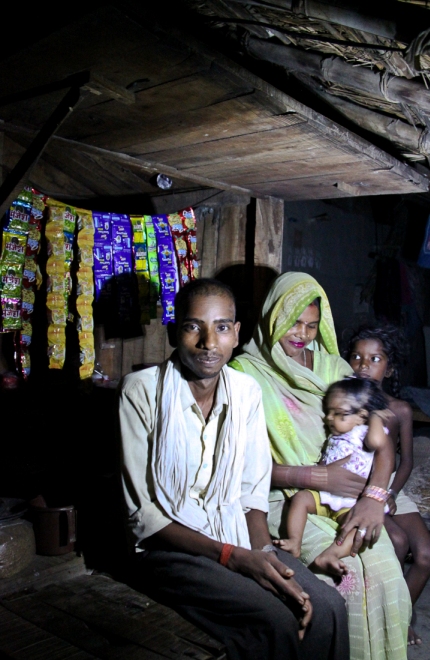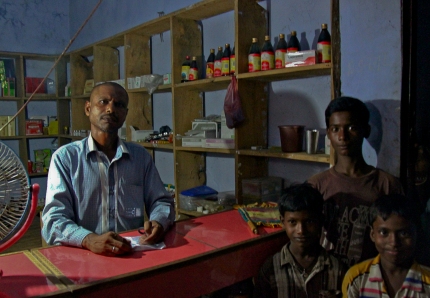A social enterprise is providing low cost solar power to some of the poorest households in northern India.
In Uttar Pradesh, one of India’s largest, most populated states, over 60% of households (125 million people) live without power. In Sitapur district, one such pocket of absence, a small social enterprise called Mera Gao Power (MGP) is trying to change things, two solar panels at a time.
In just over a year, MGP has connected more than 3,500 customers to solar power mini-grids at a village level. Anna da Costa visited Sitapur district to see how new energy services have changed the lives of people living far away from the straining national power grid.
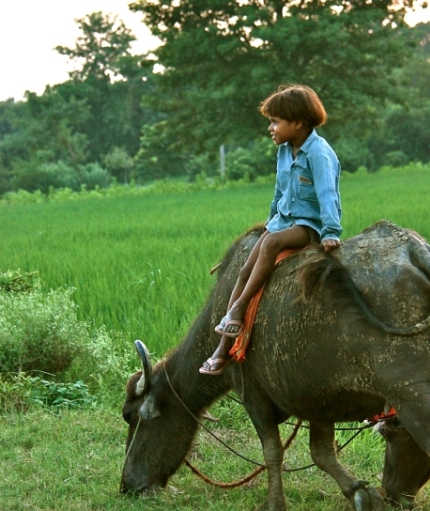 Remote villages beyond the grid
Remote villages beyond the grid
The fading light begins to slope and redden as evening approaches in Sitapur district, north-central Uttar Pradesh. As you journey here from the bustling city of Lucknow, you travel not only across space but time, too, into a medieval world of smoking wood fires, trundling bullock carts and mud-walled, straw-topped huts. There is little electricity here, and almost no access to clean water or basic sanitation. The summers are scorching and the winters frigid yet at this time of year, just after the rains, a cool breeze tousles the teeming grasses blissfully. Even this heavenly vision, though, veils the challenges that were brought to the region by heavy monsoon rains this season, which swelled the Ghaghara river’s banks to bursting point, inundating more than seventy villages and multiple croplands.
Solar solutions
Village by village, MGP are building a network of low cost solar micro-grids that provide two LED lights and a mobile charging point to all paying households at a cost of 25 rupees [US$0.5] per week. That is cheaper than the equivalent kerosene and mobile charging costs from the nearest town, which can be almost double across a month. Solar power, as a “smokeless” source of light, comes with added benefits to customer health.
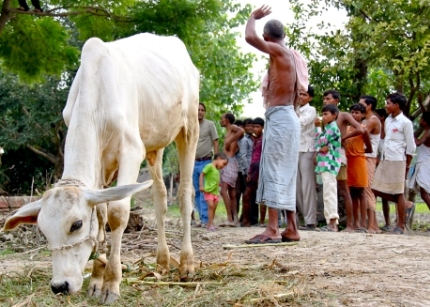 A village affair: building the grids
A village affair: building the grids
Installing a micro-grid is a grand event in the village and everyone gets involved. Here in the village of Damdampurawa, the team maps the village house by house beneath the scorching mid-day sun, working out where to place each wire so as to connect customers to the power source. Some householders joined in while others looked on, smoking a chillum, calling out orders, or watching the curious proceedings wide-eyed.
MGP maintains responsibility for these grids after they are installed. The only price the customers pay is for the connection and the energy itself, which they are provided with for seven hours each night. “This is an essential part of our model”, says Sandeep Pandey, their operations manager. “It’s designed not to place high price burdens on our customers, who are amongst India’s poorest”.
Poor quality materials can flaw a grid from the start and have proved a problem for the company in the past. Here, Sandeep, Nikhil and Raj Kamal, members of the MGP team, test the wires that they plan to lay in the village of Damdampurawa to make sure they are working well.
The roof of a sturdy, brick walled home in each village is always chosen as the site for the panels and the battery. Azaz, one of the company’s first electricians to be recruited from the local district block of Reusa, installs the panels in a southerly direction to capture as much sunlight as possible. A pair of panels is usually enough to serve up to 50 households (the average size of a village in this area), but the typical uptake in any one place is closer to 25 – about half of the village.
When a system is installed, each light can be seen as a small square LED, placed wherever the customers want it in their house. Saroj Kumari (left) and Kavita (right) stand next to one of their new lights, which has been placed on the outside wall to illuminate their front porch.
Once the systems are in place, all that remains is to wait for nightfall. The lights are designed to switch on at a time the villagers choose, which is normally just as night approaches. Here, in the village of Sewanpurawa, a crowd gathered in the settling dusk. All of a sudden, the village became alight with bright glimmers, in kitchens, bedrooms and porches, in front of small shops and beneath awnings.
“Everyone gets busy with their work thanks to the good, bright light. We’re saving our environment with these lights, and there’s no pollution in our homes either,” says Prem Kumar Rastogi, a farmer from the village of Dalpatpur.
The ability to regularly charge phones also allows villagers to be connected, share information and ideas, and even watch films and listen to music.
New businesses are starting to emerge amongst the customers too, says Pandey. “In one village, customers are using the light to make saris by night, in another entrepreneurs have started crude manufacturing of eye glasses, and one man now has a night business making plastic table cloths”, he says.
Here, Santosh Kumar, a farmer from the village of Baldipurawa, sat with his niece on their newly-lit porch. “It’s nice to have light while we cook and eat”, he told us. “Now we can actually see our food, and if there are insects or other things falling in it”.
Sushil Kumar and Sushila Devi, also from the village of Bidthauli, are now able to keep their shop open late into the evening. “These days, I can see my customers as they come and go”, said Sushil Kumar. “The children are studying more now, and we can charge our mobile phones in less time as we don’t have to visit the town to do so”.
Kushuma, from the village of Sewanpurawa uses her lights to cook into the evening. “We’ve had the lights for a month now, and get all kinds of benefits”, Kushuma told us, shyly. “We can cook beneath the light and see our food as we eat. I feel safer as well”.
Kallu Ram, a doctor from the village of Bidthauli now uses his lights to keep his medical store open late into the night, so he need not rely on kerosene or diesel to provide power after dark.
In the village of Sewanpurawa, children use the lights to continue their studies after dark. Parents also feel a sense of relief, as there is less danger of the children coming to harm in the darkness.
 Making the company sustainable
Making the company sustainable
MGP is seeking to expand its work further. “It was always crucial for us that the model was sustainable across multiple levels: economic, environmental and social. Scale is a part of this”, says Nikhil Jaisinghani, one of MGP’s co-founders. “We are constantly keeping an eye on how to make sure that is the case…trying, testing, failing and evolving to suit the needs of our customers as best we can”.
In the future, they also hope to diversify the services offered to MGP’s newly created network, says Brian Shaad, the other of MGP’s co-founders. “We hope this will include services such as education, awareness raising around sanitation and healthcare, entertainment, and improved access to knowledge and technologies for farming”.
“We believe that the model is slowly proving itself”, Jaisinghani noted, as we reflected on the company’s growth across its first year of operation. “At the moment we aren’t able to keep up with the demand, which I’d like to think is a good sign!”
Anna da Costa is a freelance writer and sustainability professional based in New Delhi.
This photo blog was first published on The Better India.


